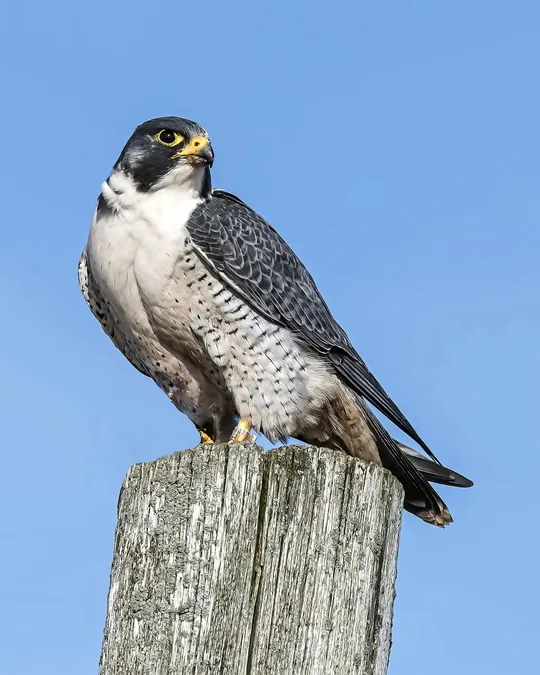
Falcon Watch: How Heavy Metal Exposure Signals a Looming Environmental Crisis
2024-11-27
Author: Siti
Introduction
Peregrine falcons (Falco peregrinus) are sounding the alarm on our planet's health, and a new study reveals that these majestic birds are being compromised by exposure to heavy metals. Conducted by the Sbarro Health Research Organization (SHRO) at Temple University in collaboration with the veterinary research group at Magna Graecia University in Italy, the research highlights the urgent need for environmental oversight and protection.
Findings of the Study
The findings show that heavy metal exposure not only undermines the immune systems of peregrine falcons but also significantly hampers their reproductive success. Moreover, persistent environmental chemicals, notably brominated flame retardants, are posing an even greater threat to their populations. These factors underline the importance of peregrine falcons as bioindicators, essentially representing the health of ecosystems and, by extension, human health.
Ecological Role of Peregrine Falcons
Known for their exceptional speed and hunting abilities, peregrine falcons sit atop the food chain as apex predators. This positioning allows them to accumulate harmful pollutants from their prey, offering scientists a critical window into ecosystem health and contamination levels. The need for ongoing monitoring of these birds has never been more pressing, particularly as modern society grapples with a multitude of environmental challenges.
Historical Context
Historically, peregrine falcons have experienced sharp population declines due to harmful substances like the widely used organochlorine pesticide DDT. The ban on DDT catalyzed a remarkable recovery for the falcon population, yet today’s environmental landscape presents new risks that demand attention.
Research Insights
In their research review, "Understanding Environmental Contamination Through the Lens of the Peregrine Falcon," Prof. Antonio Giordano and Dr. Giovanna Liguori emphasize the role of these birds in pollution studies. "Peregrine falcons can act as valuable models for investigating the impact of environmental contaminants on human health," stated Giordano, underscoring the interconnectedness of ecosystem and human health.
Monitoring Necessity
The research asserts the necessity of monitoring falcon populations to predict and mitigate diseases related to contaminants. By analyzing the levels of pollutants in falcon tissues, researchers could potentially unveil health risks to human communities that share habitats with these birds.
Call to Action
"We're not just conserving wildlife; we're ensuring a healthier planet for all species," Dr. Liguori noted. The call to action is clear: investing in advanced monitoring technologies and fostering global collaboration could pave the way for healthier environments.
Technological Innovations
Emerging technologies, including molecular biomarkers and remote sensing, offer the potential to transform how data is gathered regarding environmental health. These innovative approaches can trace pollutant origins and assess biological impacts at a cellular level, ensuring the development of more effective conservation strategies.
One Health Approach
The peregrine falcon serves as a powerful example of the One Health approach, which integrates human, animal, and environmental health. By studying the effects of pollutants on these birds, researchers can make critical connections to human health risks, encouraging an interdisciplinary collaboration between ecotoxicologists, public health specialists, and conservationists.
Future Research Directions
Moreover, groundbreaking research into semen biomarkers in peregrine falcons may illuminate the reproductive health implications of environmental toxins across species, suggesting a dire need for comprehensive monitoring of pollutants and their cumulative effects.
Priorities for Future Research
To truly harness the potential of peregrine falcons as indicators of environmental health, future research must prioritize: - Expanding monitoring programs to include new and emerging contaminants. - Utilizing advanced techniques like genomics and proteomics for comprehensive insights. - Conducting longitudinal studies to assess the long-term effects of chronic exposure on population dynamics. - Strengthening international cooperation to tackle transboundary pollution issues.
Conclusion
As we study these incredible birds, we're reminded that their fate is inextricably linked to our own. The time to act is now—let's ensure that the next generation of peregrine falcons soars free of the shackles of pollution!





 Brasil (PT)
Brasil (PT)
 Canada (EN)
Canada (EN)
 Chile (ES)
Chile (ES)
 España (ES)
España (ES)
 France (FR)
France (FR)
 Hong Kong (EN)
Hong Kong (EN)
 Italia (IT)
Italia (IT)
 日本 (JA)
日本 (JA)
 Magyarország (HU)
Magyarország (HU)
 Norge (NO)
Norge (NO)
 Polska (PL)
Polska (PL)
 Schweiz (DE)
Schweiz (DE)
 Singapore (EN)
Singapore (EN)
 Sverige (SV)
Sverige (SV)
 Suomi (FI)
Suomi (FI)
 Türkiye (TR)
Türkiye (TR)